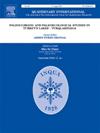A twist in the tail: on the validity and characteristics of the Phase III handaxe assemblage from Barnfield Pit, Swanscombe, UK
IF 1.8
3区 地球科学
Q3 GEOGRAPHY, PHYSICAL
引用次数: 0
Abstract
The Lower Palaeolithic site of Barnfield Pit, Swanscombe, UK, is famous for its extensive geological sequence that represents the whole of the Marine Isotope Stage (MIS) 11 (Hoxnian) interglacial. Its archaeology records a change in stone tool manufacture within the MIS 11c substage, from a Clactonian core and flake assemblage in the earliest part of the sequence (Phase I) to an abundance of Acheulean handaxes of pointed form in the Middle Gravels (Phase II). The Phase III deposits, particularly the Upper Loam, correlated with MIS 11a, have long been claimed to contain a further shift in the Acheulean tool forms, from a point dominated to an ovate dominated handaxe tradition that features tools with twisted edges. Here, we explore the character and validity of the Phase III assemblage from Barnfield Pit, combining a three-dimensional geometric morphometric approach to the study of handaxe shape alongside qualitative measures of post depositional processes. Our results demonstrate that the Phase III deposits contain an assemblage that is morphologically distinct from that within the Phase II Middle Gravels and comparable to those from laterally equivalent MIS 11a sites on Dartford Heath. At the same time, we highlight the complexity of the archaeology within the upper deposits at Barnfield Pit and suggest that the change in normative approaches to tool manufacture that is observed within the Lower Thames Valley between MIS 11c and MIS 11a may occur earlier than previously thought. This presents significant implications for our understanding of hominin social upheaval in response to global climatic cooling across Britain and northwestern Europe.
尾巴的扭曲:论英国斯旺斯库姆巴恩菲尔德坑三期手斧组合的有效性和特征
英国Swanscombe的Barnfield Pit旧石器时代晚期遗址以其广泛的地质序列而闻名,该地质序列代表了整个海洋同位素阶段(MIS) 11 (Hoxnian)间冰期。它的考古记录了在MIS 11c亚阶段的石器制造的变化,从序列早期的克拉顿岩心和片状组合(阶段1)到中期砾石(阶段2)的大量尖头形阿舍利手斧。与MIS 11a相关的第三阶段沉积物,特别是上壤土,长期以来一直被认为包含了阿舍利工具形式的进一步转变,从以点为主到以卵形为主的手斧传统,其特征是工具具有扭曲的边缘。在这里,我们探讨了巴恩菲尔德坑第三阶段组合的特征和有效性,结合三维几何形态测量方法来研究手斧形状以及沉积后过程的定性测量。我们的研究结果表明,第三阶段沉积物包含的组合在形态上与第二阶段中砾石中的组合不同,与达特福德希思地区横向等效的MIS 11a遗址的组合相当。与此同时,我们强调了巴恩菲尔德坑上层沉积物考古的复杂性,并建议在MIS 11c和MIS 11a之间的下泰晤士河谷中观察到的工具制造规范方法的变化可能比以前认为的更早发生。这对我们理解人类社会剧变对英国和欧洲西北部全球气候变冷的反应具有重要意义。
本文章由计算机程序翻译,如有差异,请以英文原文为准。
求助全文
约1分钟内获得全文
求助全文
来源期刊

Quaternary International
地学-地球科学综合
CiteScore
5.60
自引率
4.50%
发文量
336
审稿时长
3 months
期刊介绍:
Quaternary International is the official journal of the International Union for Quaternary Research. The objectives are to publish a high quality scientific journal under the auspices of the premier Quaternary association that reflects the interdisciplinary nature of INQUA and records recent advances in Quaternary science that appeal to a wide audience.
This series will encompass all the full spectrum of the physical and natural sciences that are commonly employed in solving Quaternary problems. The policy is to publish peer refereed collected research papers from symposia, workshops and meetings sponsored by INQUA. In addition, other organizations may request publication of their collected works pertaining to the Quaternary.
 求助内容:
求助内容: 应助结果提醒方式:
应助结果提醒方式:


